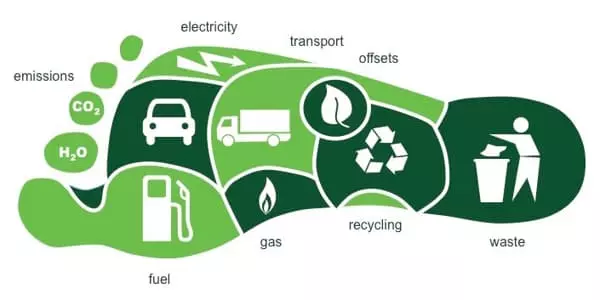Companies in the digital technology industry significantly underreport greenhouse gas emissions arising from their products’ value chain. More than half of these emissions were excluded from self-reporting in 2019, according to a survey of 56 major tech companies. The omitted emissions, at around 390 megatons carbon dioxide equivalents, are comparable to Australia’s carbon footprint. The research team created a method for identifying error sources and calculating omitted disclosures.
Companies in the digital technology industry significantly underreport greenhouse gas emissions arising from their products’ value chain. More than half of these emissions were excluded from self-reporting in 2019, according to a study of 56 major tech companies conducted by the Technical University of Munich (TUM). The omitted emissions, at around 390 megatons carbon dioxide equivalents, are comparable to Australia’s carbon footprint. The research team created a method for identifying error sources and calculating omitted disclosures.
In order for policymakers and the private sector to set targets for reducing greenhouse gas emissions, it is necessary to know how much CO2 businesses actually emit. There are, however, no legally binding requirements for comprehensive accounting and full disclosure of these emissions. The Greenhouse Gas Protocol (GHG) is regarded as a voluntary standard. It categorizes emissions into three types: Scope 1 refers to direct emissions from a company’s own activities; scope 2 refers to emissions from the production of purchased energy; and scope 3 refers to emissions from activities along the value chain, or all emissions from raw material extraction to end product use. Scope 3 emissions frequently account for the majority of a company’s carbon footprint. Previous research has also shown that these emissions are responsible for the majority of reporting gaps. However, it was previously impossible to quantify or determine the causes of these gaps.
A lack of transparency makes it difficult to set realistic targets and develop effective strategies to reduce greenhouse gas emissions, as well as to properly assess companies. The often haphazard and inaccurate reporting of companies’ carbon footprints is a problem for policymakers, stakeholders, and the companies themselves.
Lena Klaaßen
Lena Klaaßen and Dr. Christian Stoll of the Technical University of Munich (TUM) developed a method for identifying reporting gaps for scope 3 emissions and used it in a case study to calculate the carbon footprints of pre-selected digital technology companies. Their paper has now been published in Nature Communications.
Companies publish inconsistent figures
Klaaßen and Stoll discovered that many companies report different levels of greenhouse gas emissions depending on where they report them. They concentrated on the companies’ own reports rather than voluntary disclosures to the non-profit organization CDP. Based on the structure of the GHG Protocol, CDP’s annual survey of companies is regarded as the most important collection of data. The majority of companies report lower emissions in their own reports than in the CDP survey. This could be due in part to the fact that the CDP report is primarily aimed at investors, whereas corporate reports are aimed at the general public.
Furthermore, CDP allows reporting companies to choose which of the 15 GHG Protocol categories are relevant to them, ranging from business travel to waste disposal. According to the studies, this discretionary freedom leads to some companies ignoring certain categories or not fully reporting the associated emissions. Most businesses have reporting gaps because they do not receive emissions data from all of their suppliers and do not fill the gaps with secondary data.

Klaaßen and Stoll calculate emissions by applying the values of several comparable companies that report complete figures to close the gaps. They consider whether the companies are in the same industry and have comparable key indicators such as sales, profits, and workforce size. To apply a consistent benchmark, they assume that GHG Protocol categories are relevant to a company unless it expressly states that emissions in this area are non-existent.
751 vs. 360 megatons carbon dioxide equivalents
Klaaßen and Stoll used this method to calculate the scope 3 emissions of 56 digital technology firms. This industry is viewed as a major source of CO2 emissions due to its high energy consumption, but it has frequently stated that it is committed to a low-carbon business model. The case study looks into software and hardware manufacturers that were on the 2019 Forbes Global 2000 list, which ranks the world’s largest public companies, and took part in the CDP survey that same year.
According to the calculations, the analyzed tech companies did not disclose more than half of their greenhouse gas emissions along the value chain in their own reports and/or the CDP survey in 2019. Instead of the previously reported 360 megatons of CO2 equivalents, the study calculates a total of 751 megatons. The difference of 391 megatons is comparable to Australia’s annual greenhouse gas emissions.
Significant differences between companies
Half of the companies submitted data to the CDP that contradicted information in their own corporate reports. These reports were especially prone to ignoring GHG Protocol categories that contribute significantly to emissions. For example, 43 percent of companies failed to consider emissions from the use of sold products, while 30 percent failed to consider purchased goods and services.
There were significant differences in the quality of company disclosures. While some companies excluded only one GHG Protocol category, others excluded all scope 3 emission classes. The researchers discovered the largest discrepancy when comparing publicly disclosed emissions to the calculated figure, which differed by a factor of 185. The closest amounts were separated by only 0.06 percent. Hardware companies had avoided more than half of their total emissions, while software companies had avoided slightly less than half. Companies that announced aggressive CO2 reduction goals were relatively accurate in their reporting. Here the difference between the disclosed and adjusted quantities was less than 20%.
“Consider adopting binding regulations”
“The often haphazard and inaccurate reporting of companies’ carbon footprints is a problem for policymakers, stakeholders, and the companies themselves,” Lena Klaaßen says. “A lack of transparency makes it difficult to set realistic targets and develop effective strategies to reduce greenhouse gas emissions, as well as to properly assess companies.” The authors believe that, in addition to additional research on other branches, a new regulatory framework is required. “Given the current underreporting, it appears unlikely that voluntary guidelines alone will result in more accurate disclosures in the future,” says Christian Stoll. “As a result, policymakers should consider developing binding guidelines with clear rules for reporting greenhouse gas emissions.”





